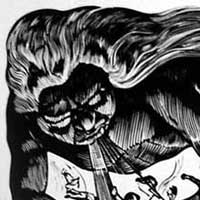 |
 |
 |
August
2003
Rafael Tufino‘s retrospective of 150 works that spans
the 1940s to the present takes place only a few blocks
from the sign shop he used to have in Manhattan’s
East Harlem from 1946 to 1947. Later, during the 1970s,
Rufino became involved in the Taller Boricua (The Puerto
Rican Workshop), which played a role in the founding of
New York’s Museo del Barrio, and since then he has
been traveling between Puerto Rico and New York. |

[ Click
on image to view works ] |
Born in Brooklyn to Puerto Rican parents, Rufino settled in
Puerto Rico in 1932. After serving in the American army in Panama
he studied at the government’s expense at the Academia
de San Carlos in Mexico, where he experimented with fresco painting,
drawing and printmaking and became influenced by the Mexican
muralists such as Siqueiros. He traveled through the country,
lived with the Zapoteca Indians and married a Mexican woman
with whom he had a daughter, Nitza. In 1950 Tufino, back in
Puerto Rico, founded the Centro de Arte Puertoriquena. Later
on he also worked as a designer and creator of posters and produced
many portfolios including “El Café” for which
he received a Guggenheim Fellowship.
For today’s viewer, Tufino’s art is notable by his
bold use of colors, the spontaneity of his line and its dynamic
quality. He has successfully combined the influence of Mexican
realism with that of 1920s and 30s Soviet posters and - especially
in his linocuts - of European Expressionism.
Though aware of these various avant garde movements, Rufino
has chosen mostly traditional themes and has anchored his work
in a strong sense of Puerto Rican identity. This choice, and
his open and generous attitude towards younger artists, have
made him a major force in furthering modern art from his country
both on the Island and abroad.
The title of Rufino’s retrospective is “Painter of
the People.” However, to me, his paintings – such
as the famed oil portrait of his mother as a tobacco worker,“
Goyita” (1953)- are not his best work. Tufino’s subtlety
and the freshness of his observation, his gift for color placement
and movement rendering, often do not translate well in his more
ambitious oeuvre, where it seems as if he has put on a stiff
Sunday suit: a muddier color, stilted gestures. When the artist
worries more about ideas and political empowerment than he does
about observing people and things - then the works do not feel
right.
Fortunately a large part of the exhibit shows his contribution
to graphic arts, and that is where his joy in being an artist
and his delicate mastery come through. Individual prints and
linogravures (often in several variations), portfolios, and
illustrated books are a large section of the show. The posters,
some created to announce or commemorate political events but
also for plays and concerts, are influenced both by Soviet posters
and by the folklore of the Caribbean . Jazzy rhythm, bold typography
and formal arrangement of primary colors convey strong messages
about life and politics without renouncing artistic integrity.
Most touchingly, Rufino’s modest studio is reconstructed
at the end of the visit, while at the beginning pages of his
diaries and sketchbooks, envelopes and letters sent to his children
whimsically combine words and images.It is in those, and in
the small faces painted on stones that populate his studio,
that Rufino’s spirit of joyful energy is best felt.
-- Carole Naggar
El Museo del Barrio
1230 Fifth Avenue
New York, NY 10029
212. 831.7272
(Wed-Sun,11am-5pm)
Until March 2, 2003.
www.elmuseo.org
Catalogue
in Spanish and English
|
|

|
|



